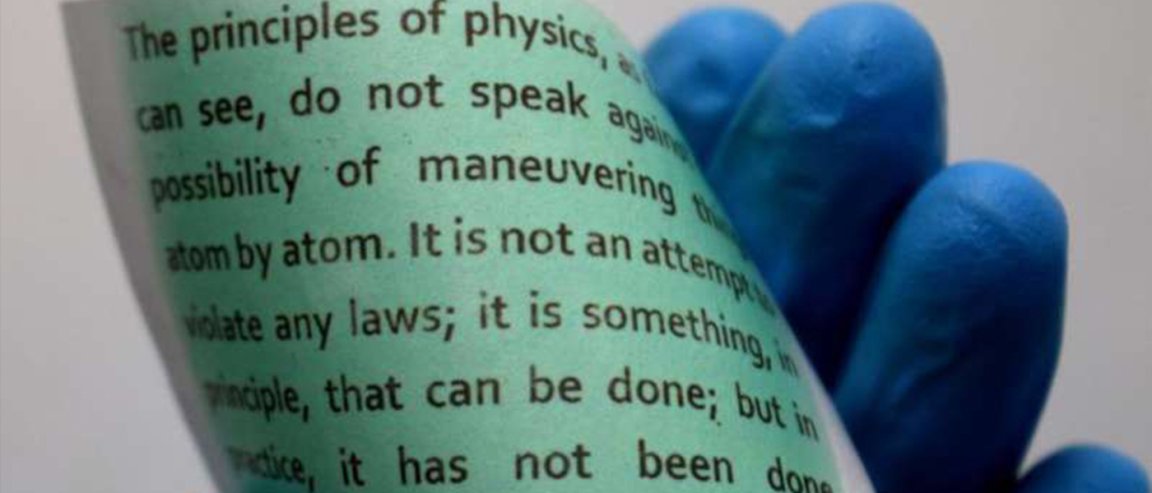
To reduce deforestation and other negative environmental impacts from paper production, researchers have developed UV light printable paper. It can be rewritten upon more than 80 times, and erased when heated to 120°C. The light printing paper uses a thin coating of nanoparticles. The color-changing chemistry of the nanoparticles, which are applied to the paper, ensure that the writing is visible until it is erased with heat. The UV light paper retains the feel of conventional paper, and is otherwise the same to use.
The coating includes two kinds of nanoparticles: Prussian blue and titanium dioxide. Prussian blue is a common, nontoxic, and relatively cheap blue pigment that loses its color when it gains electrons. Titanium dioxide (TiO2) is a photocatalyst that interacts with UV light to accelerate chemical reactions.
An even mix of Prussian blue and TiO2 nanoparticles coat the paper, which then takes on a solid blue color. Then, a printer uses UV light to print text or images — only in reverse. In other words, because it is easier to read blue text on a white background, the printer excites TiO2 nanoparticles for the background of what is to be printed, leaving only the printed text or images blue.
After it’s printed out, the paper remains stable with high (5-µm) resolution for at least five days. It then reverts slowly back to its natural solid blue state under ambient conditions, as oxidation takes place. The Prussian blue nanoparticles that absorbed electrons while activated will lose them during oxidation. If you don’t want to wait for that process to take place, however, you can quickly erase the paper by simply heating it for about 10 minutes.
The researchers for the project included Wenshou Wang and coauthors from China’s Shandong University, and additional researchers from Lawrence Berkeley National Laboratory and the University of California, Riverside. The team published a paper on their work in Nano Letters.
“The greatest significance of our work is the development of a new class of solid-state photoreversible color-switching system to produce an ink-free light-printable rewritable paper that has the same feel and appearance as conventional paper, but can be printed and erased repeatedly without the need for additional ink,” Yadong Yin, co-author of the study and Professor of Chemistry at the University of California, Riverside, told Phys.org. “Our work is believed to have enormous economic and environmental merits to modern society.”
![[Evergreen] *1* No ink required: paper can be printed with light](https://futurism.com/wp-content/uploads/2017/03/1-paper.jpg?strip=all&quality=85&w=1400&h=600)
Let There Be Light
Light is being used for far more than just helping us see things or generating solar power. Aside from this light printing method, technologies such as light-powered laptops and defibrillators that use light are changing the way we work and live.
Paper production causes industrial pollution, and paper products made up about half of landfills in 2013. Even the paper recycling process isn’t completely harmless: the process of ink removal demands energy and resources, such as water. Furthermore, the deforestation caused by paper production in the first place makes finding viable alternatives to traditional paper is critical.
This light-printable paper addresses each of these pain points in traditional paper production. The next step will be harnessing this technology for broader applications, and reducing its cost for commercial scale use.
“We believe the rewritable paper has many practical applications involving temporary information recording and reading, such as newspapers, magazines, posters, notepads, writing easels, product life indicators, oxygen sensors, and rewritable labels for various applications,” Yin said.
“The light-printable paper is indeed cost-competitive with conventional paper,” Yin said. “The coating materials are inexpensive, and the production cost is also expected to be low as the coating can be applied to the surface of conventional paper by simple processes such as soaking or spraying. The printing process is also more cost-effective than the conventional one as no inks are needed. Most importantly, the light-printable paper can be reused over 80 times, which significantly reduces the overall cost.”